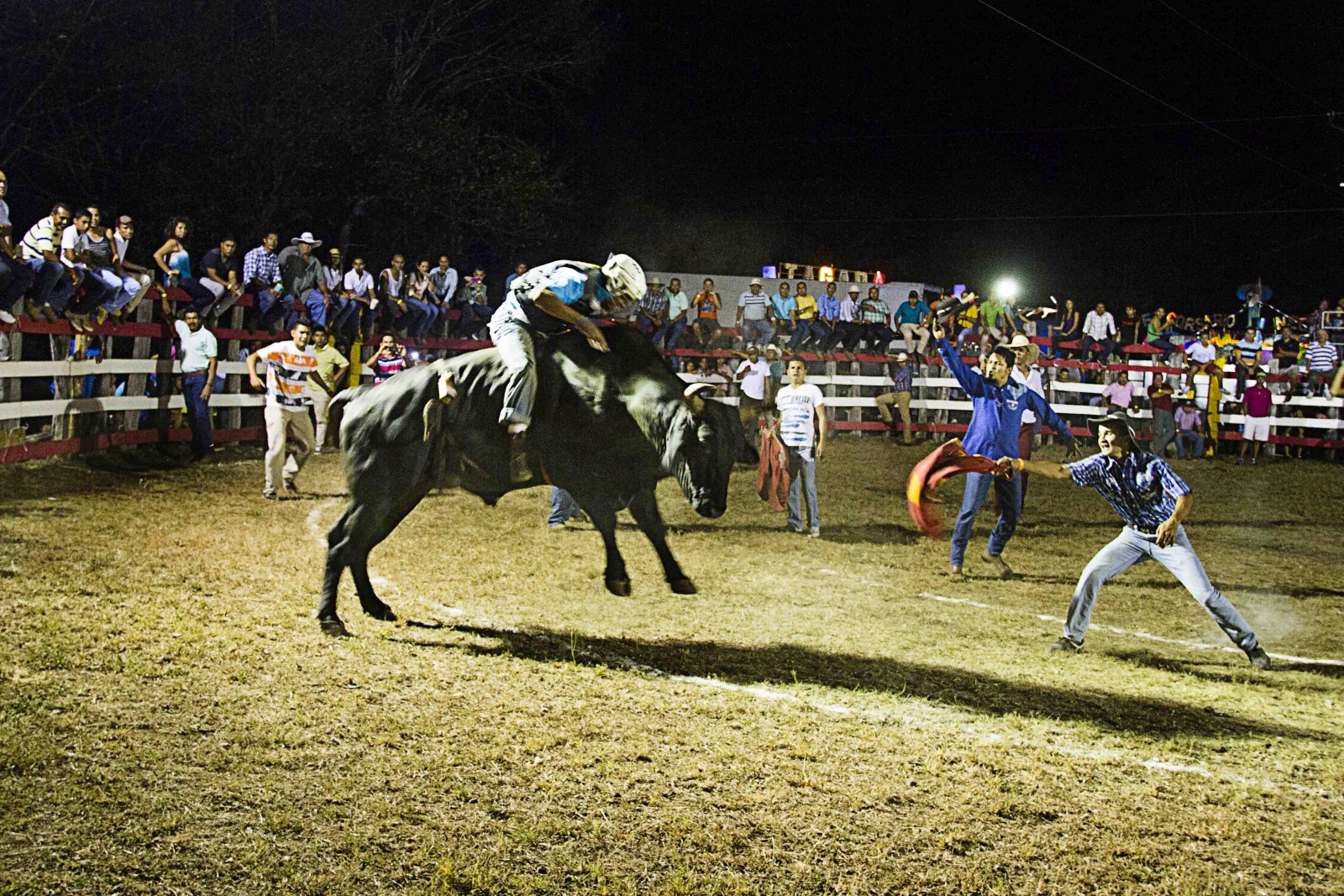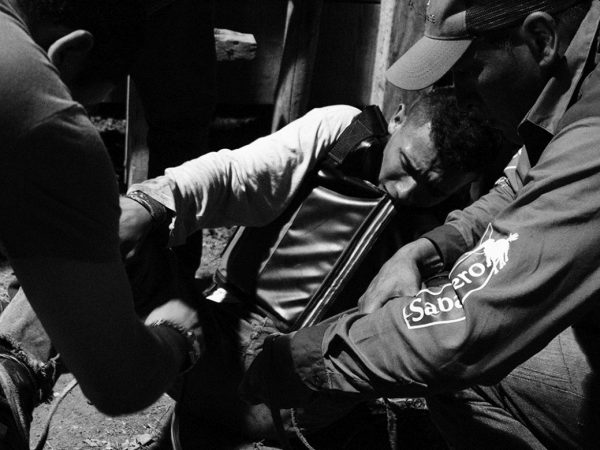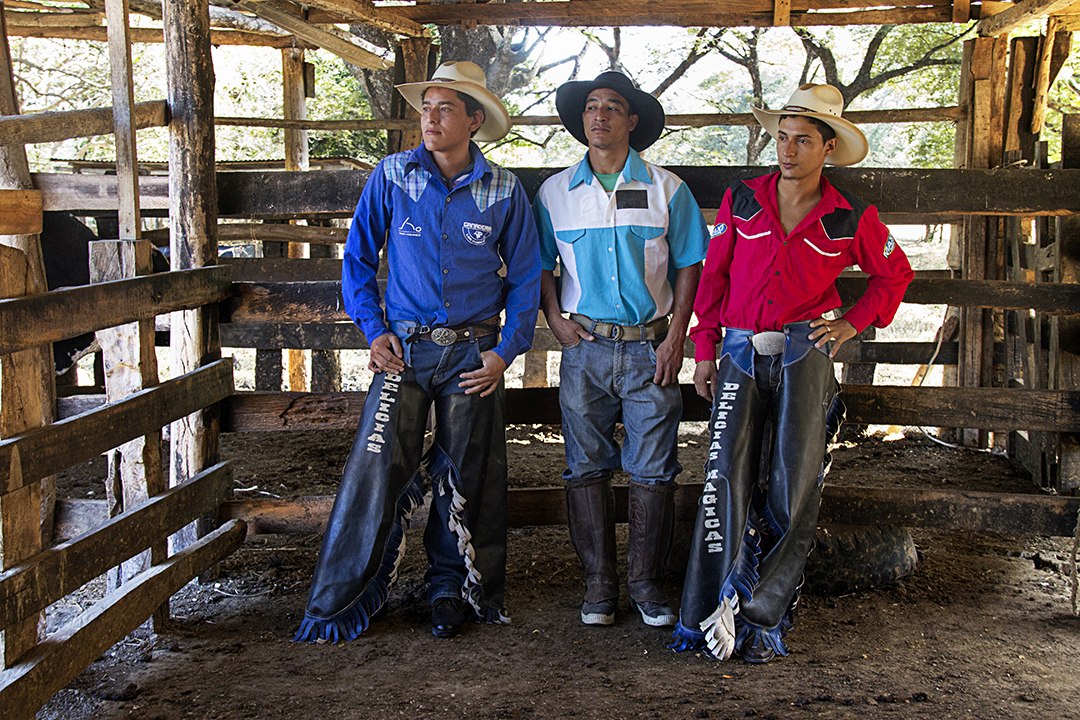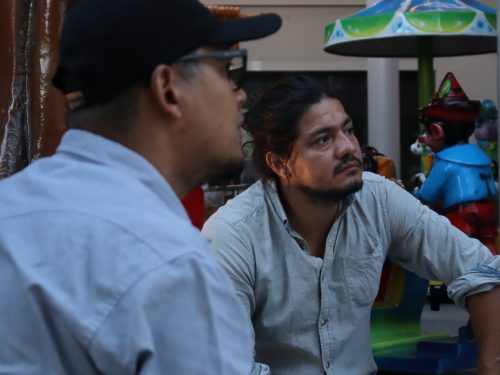
In the shadows behind the bullring in Samara on January 1, the guys gather around, dressed in blue jeans and the blue and white plaid shirts that distinguish them as members of the professional bull riders known as Los Nicoyanos. Some stand, others kneel on the ground for a group prayer. A couple of them hold a child in their arms. After the prayer, one by one, they draw a name out of a hat. This is the name of the bull they will ride tonight. Then, many of them sit around smoking to relax before it is time to enter the bullring as a group, amidst a display of fireworks, ready to give the best show they can to the spectators.
The Nicoyanos are one of three bull riding groups managed by a trio of associates in Nicoya, Mauricio Arce Villareal, Israel Flores Stoviak and Royner Villalobos Moreno. About 45 riders participate in the three groups, some practicing more than one style. As the professional group, Los Nicoyanos particpate in a championship with judges awarding them points at each event. To grip the bull and hold on better, they use a gancho spur with two 7mm nails, and a rope called a verijera is tied around the flank of the bull to cause it to kick and jump more with its hind legs. In some cases, the tail is also tied with a rabera.
Los Coloniales specialize in riding rustic style, the traditional style unique to Guanacaste that which uses a spur with a seven-point star and a curved bar, which makes it more difficult to grip the bull. In rustic style, the verijera is not used, so the bull tends to jump more with its forelegs. The ride is rougher and the rider must use more leg strength.
Los Cumiches are an exhibition group that perform more difficult feats such as facing backwards, sitting on the bulls neck instead of its back or mounting two riders at a time. They might also mount the bull in the ring instead of the bull chute.
The power of the bull is in its neck, so sitting on the neck means a much rougher ride, according to Jefferson Gomez Fonseca, age 25, from San Lazaro de Nicoya, who is a member of Los Cumiches. Although he practices all three styles, his favorite is rustic. Regardless of the style, whether holding on to the girth with two hands, one hand, or no hands, Gomez says the secret to a good ride is getting balanced on the bull while in the chute. “You have to leave the chute secure,” he affirmed.
Aside from riding bulls, Gomez works at a dairy farm, milking cows. Though he started when he was very young, neither his mother nor his grandmother nor his aunts like that he rides bulls. He lives with his grandmother, and when she sees him leave with his backpack, she knows he is going to ride, but she says nothing.
Most bull riders start riding bulls on family farms when they are young, around 14 or 15, and ride until they are between 25 and 30, but there are exceptions to every rule. The oldest rider in Los Cumiches is 40.
Jose Arnoldo Tasara Fonseca, 28, didn’t start riding until he was 25. When a ternerado (calf riding event) was held in his hometown of Mansion de Nicoya, he decided to mount one of the young bulls to see what it felt like and feel the adrenaline rush, and he managed to stay on until the bull stopped. Now he rides with Los Coloniales, and says that the more a bull jumps, the better. In March of 2013, Tasara Fonseca broke his clavicle in Samara when he was thrown against the rail, but proudly notes that the bull didn’t throw him. Five months afterward, he was riding again.
Injuries are common. The bull riders are insured by a special policy with INS (the National Insurance Institute) so they receive any necessary medical attention, assured Flores Stoviak. One of the worst injuries happened two years ago, when Carlos Mendoza ended up in a wheel chair after he crashed into the rail in Samara. He hasn’t been able to work since then. Despite injuries and risk, Flores estimated that turnover in the bull riding groups is only about 25%.
Jose Edward Obando Espinoza, age 26, from San Antonio de Nicoya, has been riding with Los Nicoyanos since 2008, when Arce Villareal got the group going about five years ago. He rode with another group previously and has been riding for about 10 years total. A bull broke his foot about a year ago, which kept him out of the ring for about six months. “When I was in the hospital broken, I said never again, but when I got out of the hospital and saw the bulls, my feet were itching to do it again,” he said.
What draws them back, again and again? The adrenaline and the excitement of not knowing how the bull is going to move.
While some consider bull riding to be cruel, Obando Espinoza assured that their groups don’t use electric prods on their bulls. “The bulls from this ranch are well trained and noble. Just by the owner talking, they understand,” he said.
The success of a ranch depends on raising good bulls, explained Villalobos Moreno A bull in Costa Rica is worth an average of 3 to 4 million colones ($6000-8000), and a good bull can sell for as much as 7 million colones ($14,000). Once young bulls reach 300 to 400 kilos (660 to 880 pounds), when they are around 2 years old, they start testing them, and if they are good bulls, they can be ridden until they are 11 or 12 years old.
Of 100 bulls tested, only 3 or 4 will be good for riding, estimated Flores Stoviak, whose family finca El Tigre Los Cumiches, is the base for these bull riders. They have 35 bulls for riding, about 75% of which were raised on the finca. One of their best bulls is Jalapeño. Although he has no horns, he kicks around in a circle that is hard to ride.
Ediver Moraga Toruño, 27, from Nicoya center, rides with all three groups and brags that he once rode the famous bull Malacrianza in Cobano and stayed on until the bull stopped. He started riding when he was 17 and admits that he was afraid at first, but not now. To stay in shape, he lifts weights at home and rides bicycle, but most of the preparation for bull riding is mental. He says the key is “to entrust yourself to God and get it into your head that you’re good and that you can stop the bull.”
Between the three groups, they participate in more than 70 bull riding events per year now. The bull riders also participate in community projects. For example, in September they helped paint the Samara school and EBAIS clinic. Last year they put on a bull riding event to raise funds for Melany Sequeira Vallejos, a girl in Garza whose leg had to be amputated because of bone cancer, and another event raised funds for two families whose house burned down in El Copal of Nicoya.
Upcoming Bull Riding Events
Date Group Place Time
February 9 Los Nicoyanos Nicoya 7 p.m.
February 10 Los Coloniales Nicoya 6 p.m.
February 14 Los Cumiches Lepanto 7 p.m.
February 15 Los Nicoyanos Lepanto 7 p.m.
February 16 Los Nicoyanos Parrita 7 p.m.
March 2 Los Nicoyanos Quepos 7 p.m.







Comments